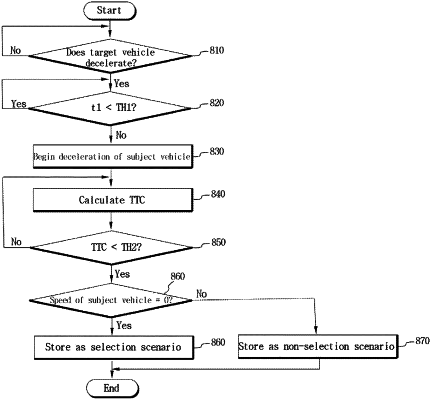| CPC G07C 5/04 (2013.01) [G07C 5/085 (2013.01)] | 7 Claims |

|
1. A vehicle collision test method comprising the steps of:
setting a speed and a target acceleration of a target vehicle;
observing a speed and an acceleration of a subject vehicle corresponding to the set speed and target acceleration of the target vehicle;
decelerating the subject vehicle and calculating a time-to-collision (TTC) when a first threshold time is exceeded after deceleration of the target vehicle; and
storing information on the subject vehicle when the calculated time-to-collision is shorter than a second threshold time and longer than the first threshold time,
wherein the storing the information on the subject vehicle includes:
setting the speed of the target vehicle to be divided into section intervals;
setting the acceleration of the target vehicle to be divided into section intervals;
selecting a plurality of scenarios by combining the set section intervals of the speed of the target vehicle and the set section intervals of the acceleration of the target vehicle; and
selecting as a selection scenario when the calculated time-to-collision is shorter than the second threshold time for the plurality of scenarios,
wherein the selecting as the selection scenario includes:
calculating a time-to-collision of the subject vehicle at preset time intervals; and
selecting a minimum time-to-collision among the calculated time-to-collisions as the selection scenario,
wherein the selecting the minimum time-to-collision includes:
storing as the selection scenario when the minimum time-to-collision is shorter than the second threshold time; and
storing as a non-selection scenario when the minimum time-to-collision exceeds the second threshold time.
|